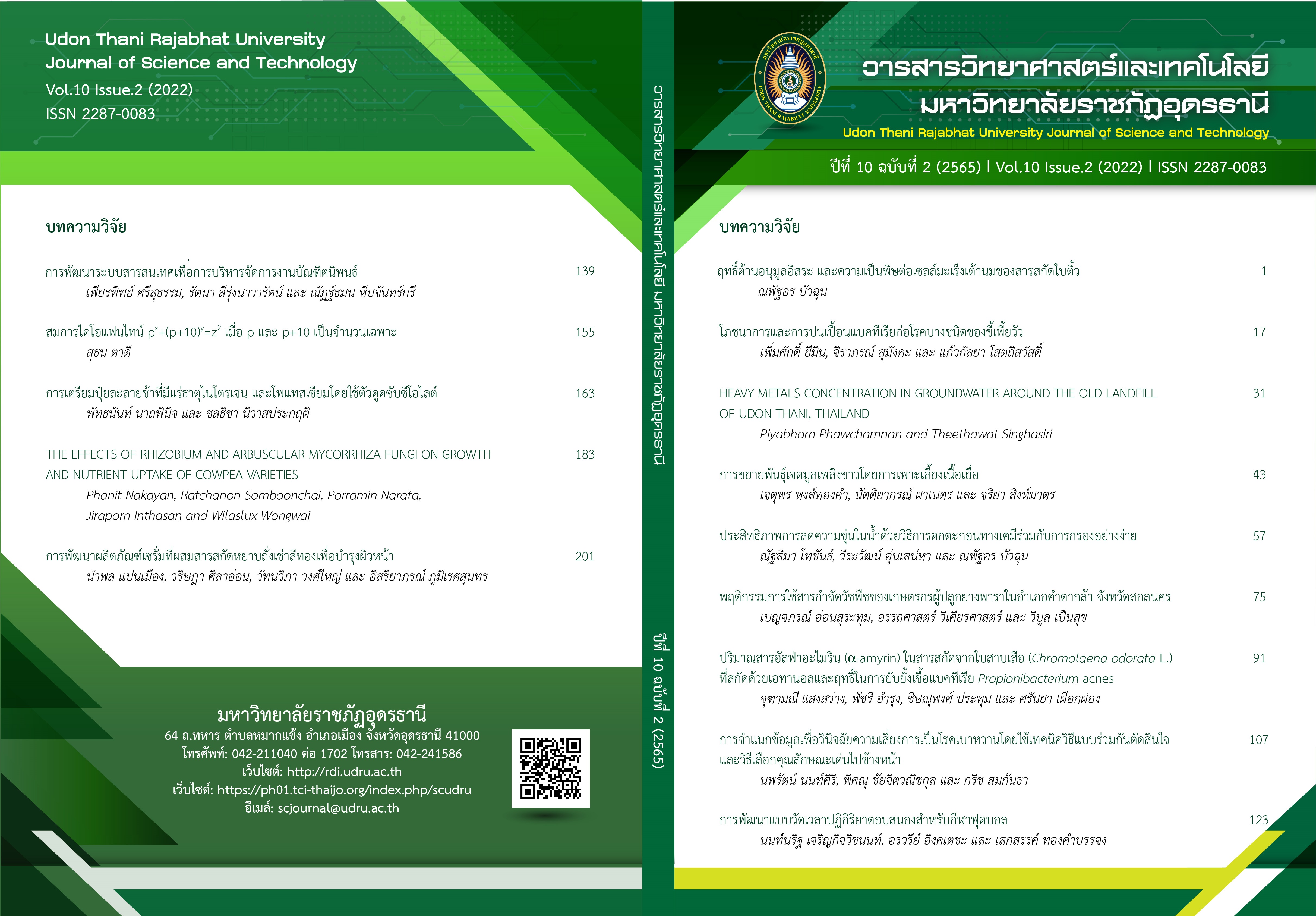โภชนาการและการปนเปื้อนแบคทีเรียก่อโรคบางชนิดของขี้เพี้ยวัว
Main Article Content
บทคัดย่อ
งานวิจัยนี้มีวัตถุประสงค์เพื่อศึกษาโภชนาการและการปนเปื้อนแบคทีเรียก่อโรคบางชนิดของขี้เพี้ยวัว โดยการสุ่มเก็บตัวอย่างจากโรงฆ่าสัตว์ ร้านจำหน่ายเนื้อโคในตลาดสดเทศบาลนครสกลนครและริมทางในเขตพื้นที่อำเภอเมือง จังหวัดสกลนคร จากผลการศึกษาปริมาณโภชนาการเฉลี่ยของขี้เพี้ยวัว พบว่าขี้เพี้ยวัวมีความชื้นเป็นองค์ประกอบสูงมากที่สุดคือ ร้อยละ 87.02±0.10 รองลงมาคือ คาร์โบไฮเดรท (ร้อยละ 6.35±0.15) เส้นใย (ร้อยละ 2.27±0.08) เถ้า (ร้อยละ 1.81±0.22) โปรตีน (ร้อยละ 1.75±0.06) และไขมัน (ร้อยละ 0.80±0.13) ตามลำดับ สำหรับผลการตรวจวิเคราะห์การปนเปื้อนแบคทีเรียก่อโรคบางชนิดในขี้เพี้ยวัว พบว่าในฤดูฝนมีค่าเฉลี่ยของการปนเปื้อนจุลินทรีย์ทั้งหมดในขี้เพี้ยวัวทุกตัวอย่างสูงมากที่สุด คือ 1.1×106 CFU/mL รองลงมาคือ ฤดูร้อน และฤดูหนาว โดยมีปริมาณการปนเปื้อนจุลินทรีย์ทั้งหมดที่ 3.5×105 และ 2.2×105 CFU/mL ตามลำดับ ซึ่งการปนเปื้อนดังกล่าวพบ Escherichia coli ในขี้เพี้ยวัวทุกตัวอย่างที่เก็บในทุกฤดูกาลมีปริมาณที่เกินเกณฑ์มาตรฐานฯ ที่กำหนดไว้ สำหรับการตรวจหา Staphylococcus aureus ในตัวอย่างขี้เพี้ยวัว พบว่ามีการตรวจพบ S. aureus ใน 4 แหล่งที่เก็บในฤดูฝน โดยมีการปนเปื้อนในปริมาณที่น้อยกว่าค่าเกณฑ์มาตรฐานฯ กำหนดไว้ (<100 MPN/mL) ในขณะที่การตรวจหา Salmonella sp. นั้นไม่พบการปนเปื้อนในทุกตัวอย่างขี้เพี้ยวัวที่เก็บมาจากทุกฤดูกาล สำหรับการศึกษาจุลินทรีย์ชนิดเด่นที่พบในตัวอย่างขี้เพี้ยวัว พบจุลินทรีย์ชนิดเด่นทั้งหมด 7 ไอโซเลท เมื่อทำการจัดจำแนกชนิดแบคทีเรียพบว่าจัดเป็น Gram negative bacilli จำนวน 4 ไอโซเลท (RA-1, WA-2, SA-3 และ SB-1), Gram positive bacilli จำนวน 2 ไอโซเลท (WA-1 และ SA-1) และ Gram positive cocci จำนวน 1 ไอโซเลท (SA-2)
Article Details
เอกสารอ้างอิง
กรมวิทยาศาสตร์การแพทย์. (2560). เกณฑ์คุณภาพทางจุลชีววิทยาของอาหารและภาชนะสัมผัสอาหาร ฉบับที่ 3 (พ.ศ.2560). สืบค้นเมื่อ 24 ตุลาคม 2564, จาก http://bqsf.dmsc.moph.go.th/bqsfWeb/index.php/bio/.
ธารารัตน์ ชือตอฟ. (2558). จุลชีววิทยาทางอาหาร. กรุงเทพฯ: สำนักพิมพ์แห่งจุฬาลงกรณ์มหาวิทยาลัย.
ธีระศักดิ์ สมดี. (2556). จุลชีววิทยาพื้นฐาน. ขอนแก่น: โรงพิมพ์มหาวิทยาลัยขอนแก่น.
นันทวัน ฤทธิ์เดช และ งามนิจ นนทโส. (2551). คู่มือปฏิบัติการจุลชีววิทยาทั่วไป. พิมพ์ครั้งที่ 2. ขอนแก่น: ขอนแก่นการพิมพ์.
นิอร โฉมศรี. (2555). จุลชีววิทยาทางอาหาร (Food Microbiology). เชียงใหม่: เชียงใหม่ ปริ๊นท์ติ้ง.
วิศิษฐิพร สุขสมบัติ. (2546). เอกสารประกอบการสอนวิชาโภชนศาสตร์สัตว์เคี้ยวเอื้อง. นครราชสีมา: สาขาวิชาเทคโนโลยีการผลิตสัตว์ สำนักวิชาเทคโนโลยีการเกษตร มหาวิทยาลัยเทคโนโลยีสุรนารี.
วีรานุช หลาง. (2552). คู่มือตรวจวิเคราะห์ด้านจุลชีววิทยาทางอาหาร. กรุงเทพฯ: สำนักพิมพ์มหาวิทยาลัยเกษตรศาสตร์.
ศูนย์การเรียนรู้อาหารไทย. (2560). ลาบขม. สืบค้นเมื่อ 2 มิถุนายน 2560, จาก http://www.thaifoodheritage.com/recipe_list/detail/54.
สุกัญญา สุนทรส และ วิเชียร ริมพณิชยกิจ. (2553). ชีวโมเลกุล. พิมพ์ครั้งที่ 3. กรุงเทพฯ: สำนักพิมพ์แห่งจุฬาลงกรณ์มหาวิทยาลัย.
แสงอรุณ กนกพงศ์ชัย. (2546). อาหาร: ทรัพย์และศิลป์แผ่นดินไทย (Thai cuisine : treasure and art of the land). กรุงเทพฯ: แปลน โมทิฟ.
AOAC. (2016). Official Method of Analysis. The Association of Official Analytical Chemist. 20thed. Gaithersburg, Maryland.
Bacteriological Analytical Manual. (2001a). Chapter 3: Aerobic Plate Count. Retrieved February 15, 2019, from https://www.fda.gov/Food/FoodScienceResearch/LaboratoryMethods/ucm063346.htm.
Bacteriological Analytical Manual. (2001b). Chapter 12: Staphylococcus aureus. Retrieved February 17, 2019, from https://www.fda.gov/Food/FoodScienceResearch/LaboratoryMethods/ucm071429.htm.
Bacteriological Analytical Manual. (2002). Chapter 4: MPN Escherichia coli. Retrieved February 17, 2019, from https://www.fda.gov/Food/FoodScienceResearch/LaboratoryMethods/ucm064948.htm.
Kramarenko, T., Nurmoja, I., Meremae, K., Horman, A. & Roasto, M. (2013). The prevalence and serovar diversity of Salmonella in various food products in Estonia. Food Control. 42, 43 – 47.
National Bureau of Agricultural Commodity and Food Standards. (2003). Compendium of method for food analysis. Ministry of Agriculture and Cooperatives, Bangkok.


